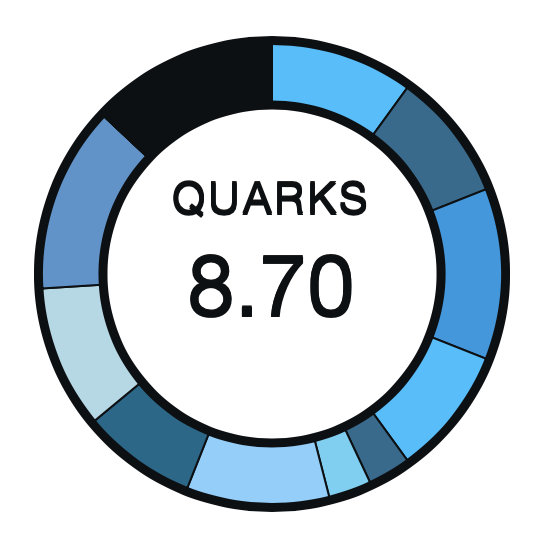
Quarks rating explanation here.
Hardware Design
Rating: 9.5/10
True to Sennheiser’s core principles, the PXC-550’s are minimalistic and elegant. A matte finish and some chrome and silver accents on the cups add to the refined look.
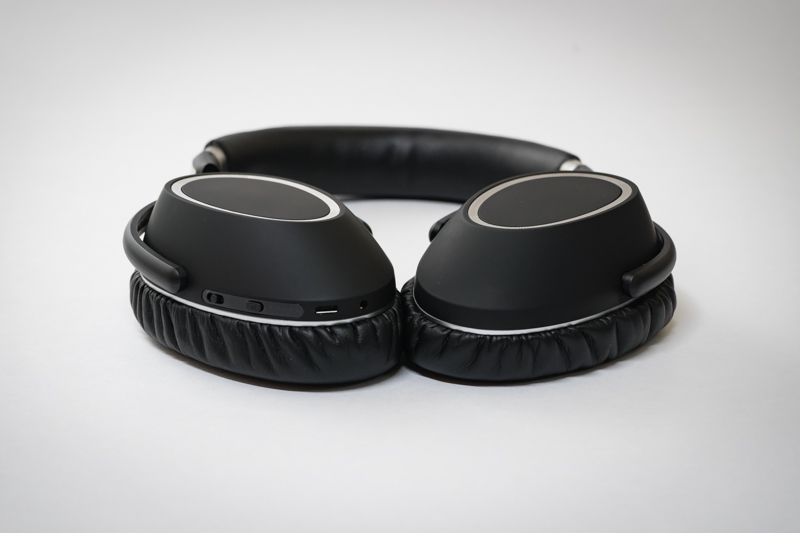
There are only three buttons: 2 sliders for controlling the NoiseGard level and bluetooth connection and one push button to circle through sound effects (more on that later). Buttons are discretely placed on the edge of the cups. All but the bluetooth connection slider are fairly easy to reach, even while wearing the headphones. One important feature is that there is no On/Off switch. The headphones are automatically turned on by rotating the earcups and putting them in the hearing position. Thus, they turn off automatically when collapsed. This is achieved through a couple of electric contacts in the earcups’ pivotal section (see below).
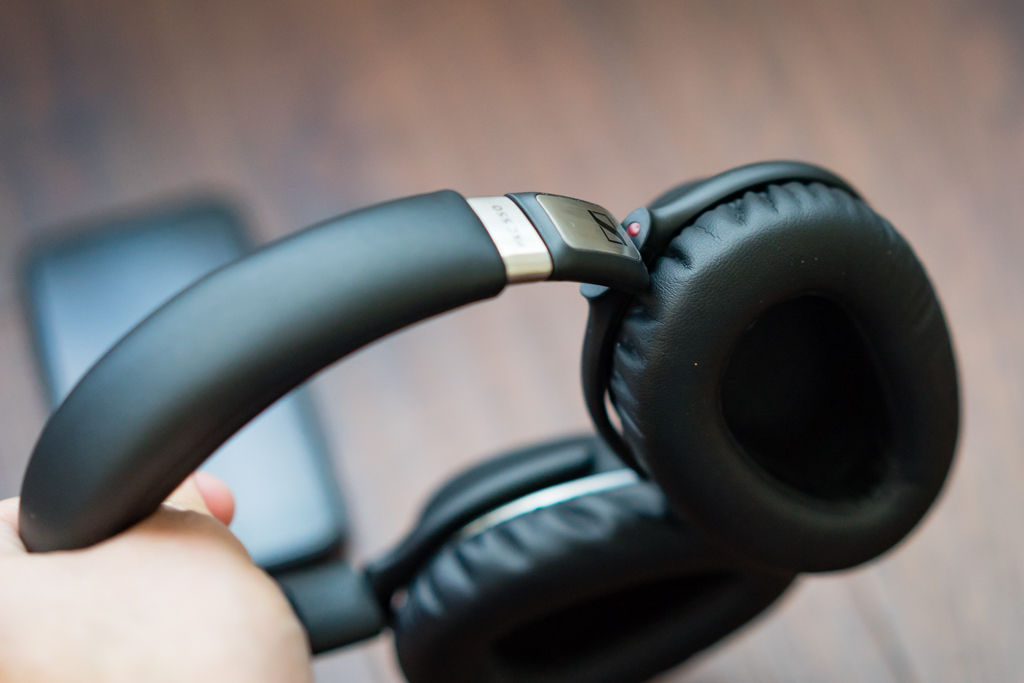
It takes a while getting used to not having a designated On/Off button, but I’ve come to appreciate it. One less thing to think about and you don’t risk to leave the headset turned on once it’s stored in the included case.
In addition to a fairly slim case, Sennheiser provides a charging cable, an audio cable with a 3.5 mm plug, and plug adapters (6.3mm connector and inflight entertainment). I would have liked seeing a semirigid case like the one offered by Bose in some of their products, though.
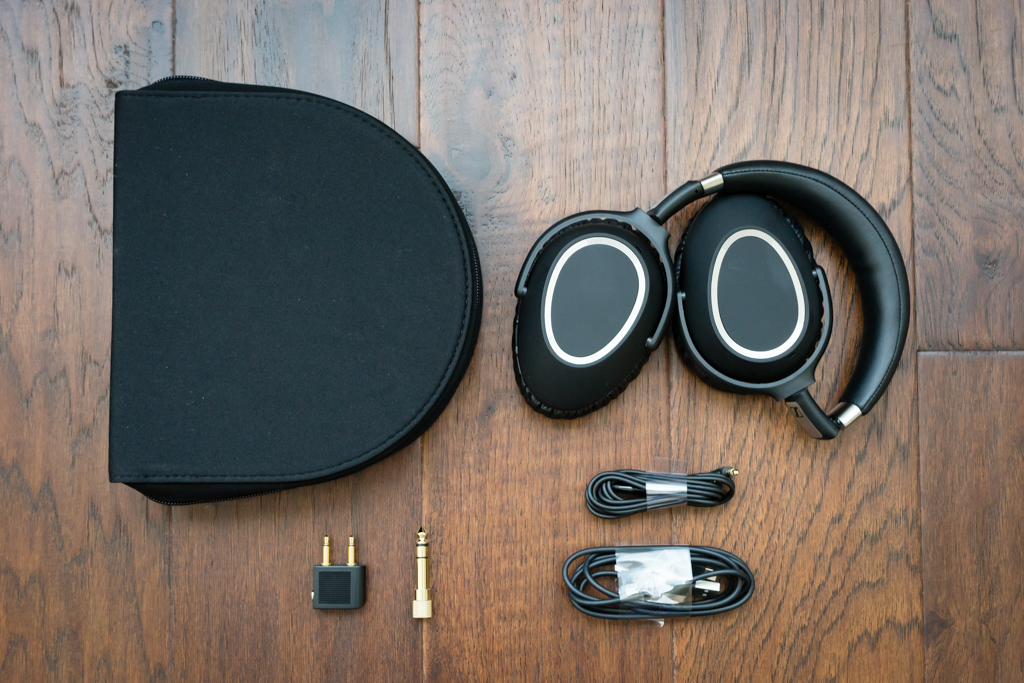
The PXC-550’s are extremely comfortable, more so than the Momentum 2.0 Wireless and on par or better than the Bose QC35, in my opinion (and I’ve tried them all for hours). The headphones hug the head gently but securely at the same time. Just the right amount of pressure to keep them in place and almost adhered without feeling they are clamping your head. I didn’t feel any pain on either the temple area or around ears when wearing them with glasses. These are the most comfortable headphones I’ve used so far.
Touch sensitive controls are discretely provided on the external surface of the right ear cup. Thus, swiping left or right goes back or skips tracks respectively. Conversely, swiping up and down increases/decreases volume. These controls are very responsive and seem to work better than those on the Beoplay H7 (review here).
Hardware Quality
Rating: 9/10
The headphones are made of high quality plastic, leather and metal accents. Although plastic is used extensively, they feel better built than the Bose QC35, or the Beats Studio Wireless, which can be a little too plasticky. Although the Sennheiser offering is sturdy, well constructed and doesn’t feel cheap at all, they don’t feel as high end as the Momentum 2.0 Wireless or Beoplay H7. That’s probably not a bad thing since the high end designation usually comes at a cost: heavier materials and sometimes clunkier designs. Although the PXC-550’s are just 30 grams lighter than the Momentum 2.0, they feel extremely lightweight, you can definitely tell the difference when using them.
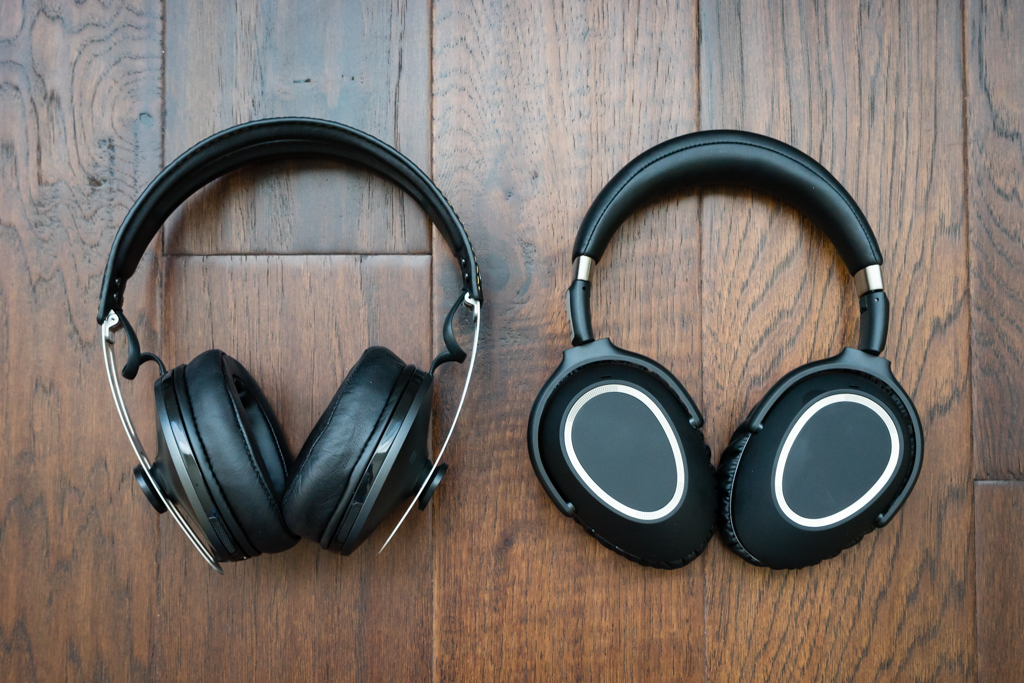
The ear cups materials do an excellent job concealing fingerprints. Surfaces in contact with the ears are made of very soft leather. Also, the headband is wrapped in nicely cushioned leather and can barely be felt while wearing them. Overall, built quality is excellent.
General Performance
Rating: 9.5/10
I tested the Sennheiser PXC 550 in both wired and wireless mode. For both types of connection I used high resolution audio. That is, music encoded at (at least) 96KHz/24 bit, which is effectively better quality than CD audio (and hence, better quality than compressed lossy formats like MP3 and AAC). The files were in either FlAC format or Apple Lossless format. Here is the setup for each connection:
Wired Connection: Music was played from a Macbook Pro and decoded through an external DAC capable of reproducing it at 96KHz/24 bit resolution.
Wireless Connection: The Bluetooth connection between the Macbook Pro and the headphones was made through the aptX Codec(supported by both devices), which provides a CD-like audio quality. At the time of writing, it’s the highest possible audio quality that can be achieved over a Bluetooth connection.
I wanted to test the headphones with the cleanest audio source I could provide to rule out any quality issues or noise/artifacts that may be introduced. The whole arrangement may be overkill for mobile users because of the following reasons:
- Currently, most mobile devices (including Apple’s iPhone 6S) are not capable of playing high resolution audio through the headphone jack while keeping the lossless audio quality (iPhone 7 might have changed that by using the lightning port).
- The most popular streaming services (e.g. Spotify and Apple Music) are not capable of streaming music at such high quality (Tidal, however; can steam at CD quality).
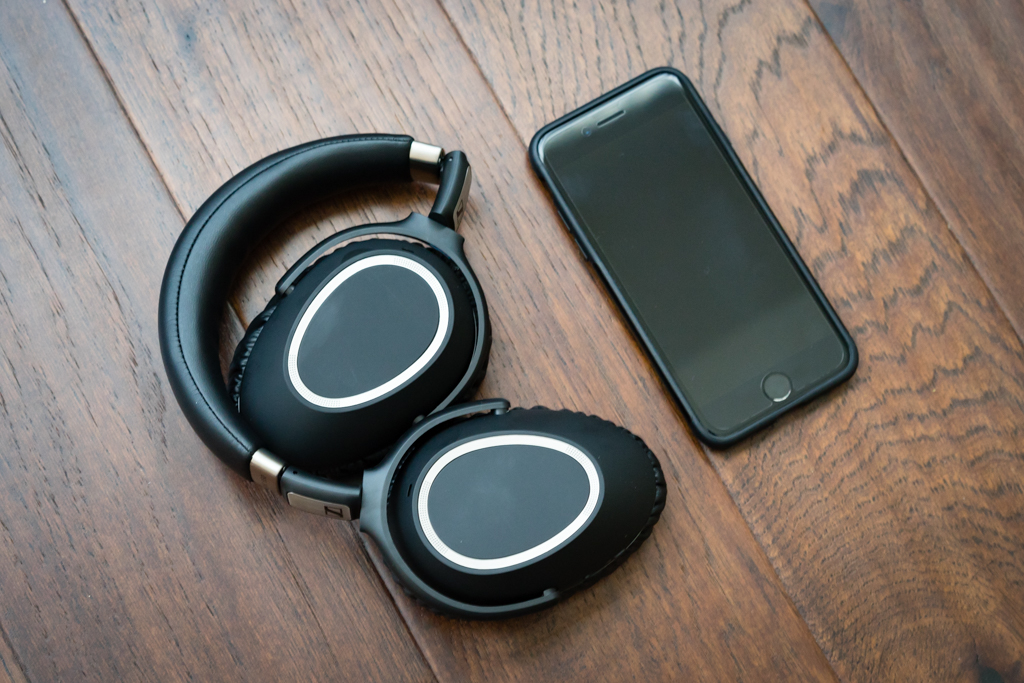
Overall, the PXC 550 provides an exemplary flat response, no emphasis on either lows or highs. Mids are crisp and clear and low frequencies are adequately controlled, although can become quite prominent when needed. The Sennheiser Momentum 2.0 wireless has a slightly better/deeper bass (or perhaps a pronounced “V” shape?). Keep in mind, however; the sound profile can be easily adjusted. There is two ways to accomplish that: Through the equalizer on the iPhone App (more on that later), and through the predefined sound effects.
There are 3 sound pre-configured effects: Club, Movie and Speech (well, there is actually 4 effects as you can create a custom one called Director through Sennheiser’s iPhone App). When pressing the Sound FX button on the right ear cup, the headphones circle through the effect modes while a woman’s voice tells you which one is currently active (definitely a nice touch). I tend to use the Club mode quite often as it enhances bass a bit. Keep in mind these modes affect the audio reproduction regardless of the phone App being used to play audio, as opposed to the EQ feature (more on that later).
Although the wired connection seemed to be just a tad clearer (which is just expected given the current wireless technology limitations), I was quite impressed by how exceptionally well these headphones performed. Seven Nation Army by The White Stripes sounds just splendid, even more so after setting the headphones on “Club” mode (i.e. enhances lower spectrum and voices). Because of the general flat sound profile (i.e. not exacerbating any part of the spectrum), strings and voices in The Way I am by Ingrid Michaelson sound just exquisitely. If you want to give it an extra punch, just create a Director setting in the Sound Effects and raise the 4 settings just one notch. Almost magical.
Sennheiser’s active noise cancellation technology, NoiseGard, can be controlled from either the headphones (slider button) or the phone App. It has two intensity levels and can also be turned off, which is great if passive isolation is good enough or if you are not in a crowded place or an airplane. I wish more manufacturers allowed to turn the active noise cancellation off.
Price
Rating: 7/10
The Sennheiser PXC 550 is priced on the high side. It’s actually $50 more expensive than the direct competitor, the Bose QC35 and about the same price as the Beoplay H7 (previously reviewed here). However, sound quality is definitely better than Bose’s offering and the noise canceling technology works better, in my opinion. After trying these headphones and the Bose QC35 for hours, I think the extra dollars are absolutely worth it.
Ease of Use
Rating: 10/10
Sennheiser has gone the extra mile to assure these headphones are very simple to use. From minimal buttons to touch sensitive surfaces for controlling music. There is even a feature called Smart Pause that can be enabled in the iOS App in which the headphones automatically pause music when they are taken off your head (music resumes when put back on). Also, turning NoiseGard on and off can be easily done by just flicking a switch.
Other Pros
Rating: 10/10
This section is intended to give credit to extra features that set the reviewed device apart from competing devices. In the case of the Sennheiser PXC 550, some of these features are:
- iOS and Android App for configuring sound profile.
- User configurable EQ and sound effect profiles.
- Responsive and well designed touch sensitive controls.
- Auto-pause/resume feature.
- 2-levels of NoiseGard with the option of turning it off completely.
- aptX codec for cd like audio quality.
Software Design
Rating: 8.5/10
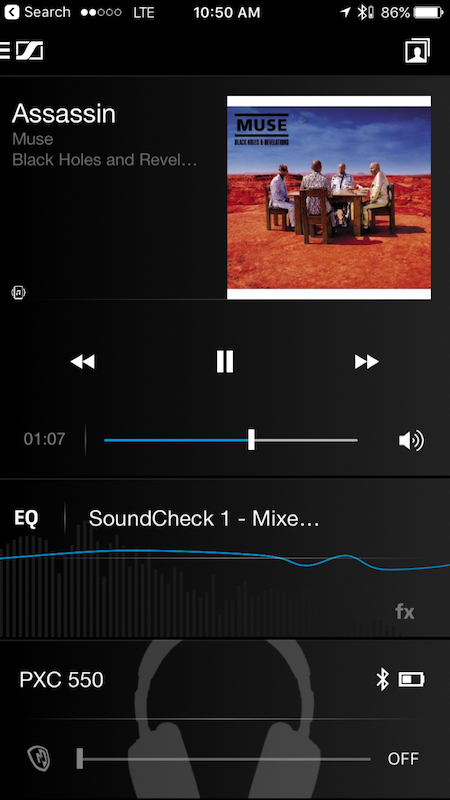
Captune is Sennheiser’s companion App for their wireless headphones (available for both iOS and Android). The design is simple and tasteful. The main screen is comprised of 4 panes: Album/Song art, play controls, equalizer/sound effects controls and headphones status (battery charge, NoiseGard and bluetooth connection). Tapping onto each pane shows additional information.
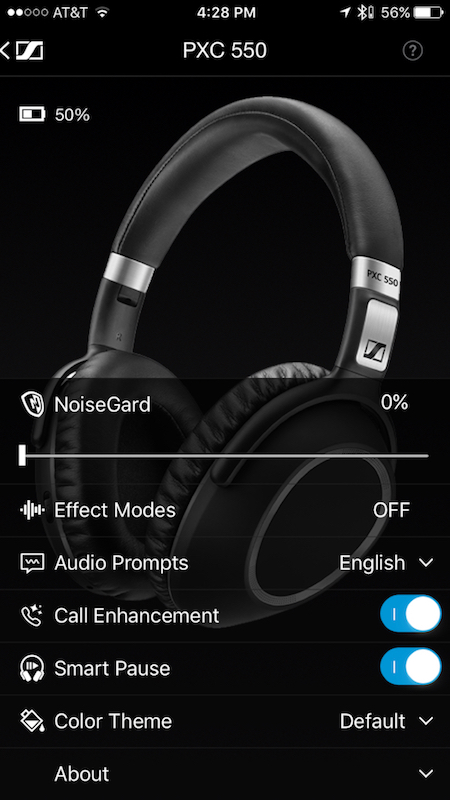
The App is well laid out and easy to navigate. The equalizer is straight forward to setup, with no confusing quadrants or ambiguous configuration terms as seen in other Apps. Pretty much all headphones features are just a couple of taps away.
You music library can be controlled from the Captune App, which may seem a bit redundant as you can just use the Music App or any other player app installed on the phone. However, I suppose Sennheiser designed it that way in an effort to having tighter control over the music reproduction and to offer additional functionality. For example, there is the capability of connecting to Tidal and there is even a free trial period included.
Software Performance
Rating: 7/10
Navigating Sennheiser’s Captune iOS App is a pleasant experience, it feels pretty responsive and well put together. However, sometimes it struggled recognizing the headphones, even when they were already playing music through a different app over Bluetooth. I would have to close it, reopen it (several times) and wait for a couple of minutes to get it to work.
The headphones’ sound signature can be modified through the App. However, in order to use the App’s Equalizer feature, songs should be played through the Captune App instead of the Music App. This may or may not be a big issue depending on your case. If you have all the music you want to listen to on your device, it shouldn’t be that big of a deal. However, if you subscribe to a service such as Apple Music and the song you are listening to is not downloaded to your device, you won’t be able to play it through Captune App.
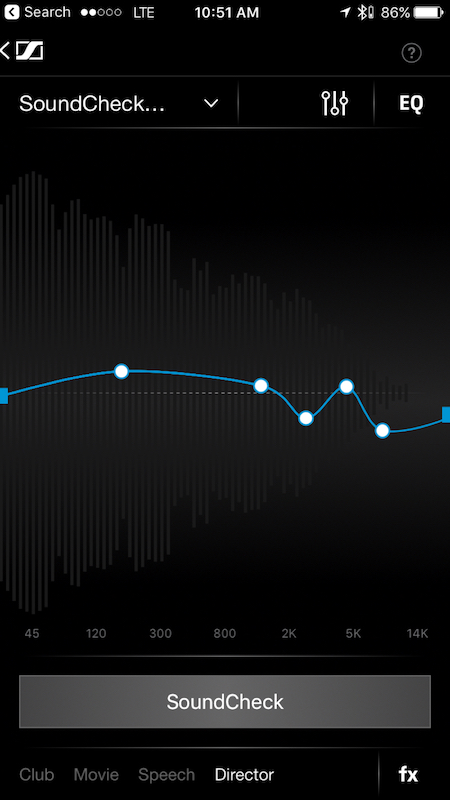
This is one of the few criticisms I have towards these headphones. The EQ on the Captune App should be capable of working regardless of which application is used to play music (e.g. Apple’s Music App, Spotify, Dezzer, etc.). Hopefully this is something that can be remedied through an App update. It’s worth mentioning, however; that the sound effects work perfectly regardless of the application being used to play music. Also, all settings are persistent, meaning they are kept as configured after the headset is turned off and back on.
Battery Life
Rating: 9/10
Sennheiser claims up to 30 hrs of battery life on their website. However, my tests were closer to 26 hours, but that may have been because I was trying pretty much all features, changing settings constantly and interacting with the App on a frequent basis. Regular day-to-day use may be closer to the rated 30 hours.
Other Reviews
Rating: 4.2/5
The Sennheiser PXC 550 has a rating of 4.2 out of 5 stars on Amazon (93 reviews), making them one of the most underestimated pair headphones currently on the market, in my humble opinion. Since there are no other reviews on Adorama or Neweeg, only the Amazon’s rating has been factored in when calculating the Quarks rating.